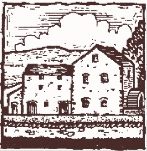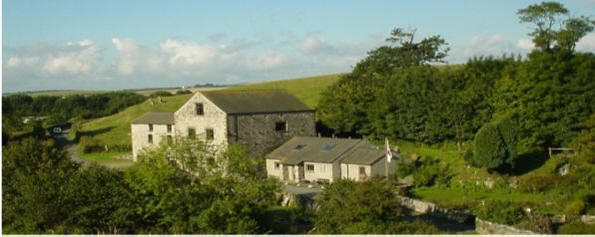| |
History and background
The small sheltered north - south valley
with its prolific fresh water spring is thought to have supported a thriving
community from the Mesolithic. Many flint artefacts have been discovered
from this period and some are displayed in the mill today.
An excavation in 1993 discovered a man made water course fed directly from
the spring and dated from the 11th century by pottery in the context. This
could have powered a small, simple single stone mill.
The first watermill on the present site is believed to date from the early
1300s, about the same period as Gleaston Castle just to the north, and
now in ruins. This is supported by archaeology which provides much evidence
in the current building of previous structures, and from the construction of
the watercourse which runs through the castle grounds. The castle was the
home of the Lord of the Manor of Muchland, and the watermill was the
manorial mill.
| top |
The Early Mill
The early building was almost certainly a two
storey mill used to grind oats, and possibly pulses such as peas and beans.
A testimonial by Thomas Benson in the 16th century says that mill stones
were brought from Sandside (Near Ulverston - where they were landed by
boat), by the villagers of Bardsea and put into place by the villagers of
Gleaston and Scales, for which they were rewarded with meal and ale. A
census in the 17th century records 17 people working and living in the mill.
During this period the wheel was driven from a man made water course (leat)
taken from the beck (stream) at a weir located half a mile to the north of
the mill and just to the west of the castle. The source of the beck is
Urswick Tarn, which around the end of May to early June does not produce
sufficient flow to drive the mill. The mill would not be able to turn again
until the autumn rains started around September, at the same time as the new
harvest was brought in. It was classed as a winter mill.
| top |
The Present Mill
Re-built in 1774, the present structure is a typical imposing Georgian
building of three storeys, the walls and lintels of which contain much red
sandstone, which was probably taken from the ruins of Furness Abbey. The
roof was made of local Burlington blue slate from quarries at
Kirkby - in - Furness and it was re-roofed with slates from the
same quarry in 1990.
Being on a much grander scale, the rebuilt mill needed to improve
production, so a second leat was built to take water north from the spring,
through underground culverts by the castle, and feed back into the beck just
upstream of the existing weir. The mill could now produce all year, and in
fact can run from the spring alone in the driest of summers. The new mill
also had French Burr stones installed and was capable of milling wheat in
addition to oats.
| top |
Milling Families
The name of the miller at the time of the
rebuild is not known, but the Thexton family were tenants from the early
1800s until about 1898. They had 13 children, the last of whom
drowned in the leat by the water wheel aged 2 - the only known accident in
the history of the mill. The family lived in the house adjacent to the mill
and enlarged at the time the mill was rebuilt.
The Huartson family moved to the mill after the Thextons and remained until
1906 when their cousins, the Edmondsons took the tenancy.
The Edmondson family continued milling for human consumption until the
1920s, but the introduction of small, cheap, roller mills and improving
steam and internal combustion engines to power them, made water powered
mills non viable. However as the mill had a drying kiln and oats could not
be milled until the moisture content was reduced, local grain producers
still needed to bring oats when damp or wet.
The mill also produced crush for animal feed, and this process continued
until 1948.
The Edmondsons bought the mill from the Cavendishes of Holker in 1921.
In addition to milling, the family were small farmers and market gardeners
cultivating around 40 acres and selling some of their produce through the
market in Barrow-in-Furness.
Agricultural activities ceased in 1960, but the mill remained in the
ownership of Marie (Ainsworth) Edmondson until 1987 when it was bought by
the Breretons.
| top
|
The Restoration.
Although general maintenance was carried out
over the years, there was a general deterioration in the buildings.
Virtually no repairs were done after 1960, so by 1987 much of the roof and
many floors had disintegrated, drain pipes had gone and gutters had failed.
Fortunately Marie's husband, Tom, was using the top floor of the main mill
to keep racing pigeons and put up plastic sheets were the roof was leaking.
This provided protection for the mill machinery, so it was in reasonable
condition.
The Breretons started renovation work in 1989 and completed the roofs and
gutters in 1990 which stopped any further deterioration of the building
fabric. Due to the considerable cost involved, ongoing renovation work is
being done as and when time and money is available, but it was substantially
completed by 2000. There are still ongoing projects which will go on for
years.
| top
|
The Future
Having invested substantial time and money in
this private project we would like to ensure the future of Gleaston Water
Mill as a record of our history and heritage. It is our current intention to
eventually pass the property into a trust to protect it from future
commercial development.
| top
| |




